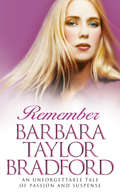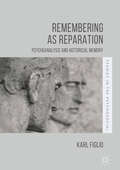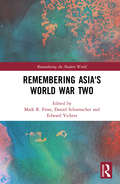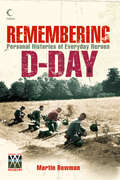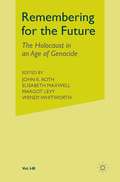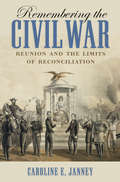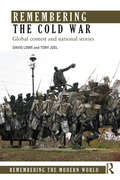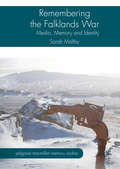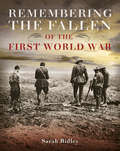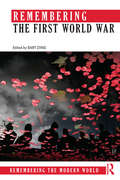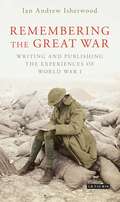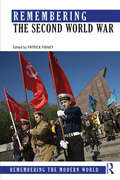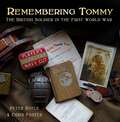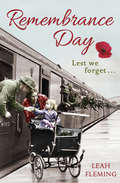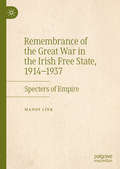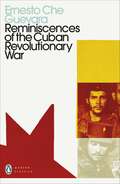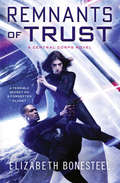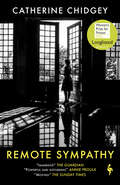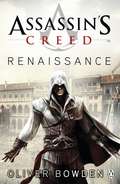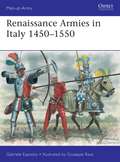- Table View
- List View
Remember (Isis Cassettes Ser.)
by Barbara Taylor BradfordA woman, an obsession, an unforgettable bestseller.
Remembering as Reparation: Psychoanalysis and Historical Memory (Studies in the Psychosocial)
by Karl FiglioThis book brings together psychoanalysis, clinical and theoretical, with history in a study of remembering as reparation: not compensation, but recognition of the actuality of perpetration and the remorseful urge to rejuvenate whatever represents this damage. Karl Figlio argues that this process, intensively studied by Melanie Klein, is shadowed by manic reparation, which simulates, but is antithetical, to it. Both aim for peace of mind: the former in a guilt-induced attitude of making better a damaged ‘good object’, internal and external; the latter, supported by defences thoroughly studied in psychoanalysis, in claiming liberation from an accusatory object. This psychoanalytic line of thinking converges with historical scholarship on post-war German memory and memorialization. Remembering is posited as ambivalent - it is reparative, in ‘remembering true’, with respect and self-respect. It is also manic reparative, in ‘remembering false’, shedding bonds to the actuality of history through acts of triumph and liberation. This thoughtful book highlights new features of history and memory work, especially the importance of emotion, and will be of great value to students, academics and practitioners across the fields of psychoanalysis, memory studies, German studies and modern history.
Remembering Asia's World War Two (Remembering the Modern World)
by Mark R. Frost Daniel Schumacher Edward VickersOver the past four decades, East and Southeast Asia have seen a proliferation of heritage sites and remembrance practices which commemorate the region’s bloody conflicts of the period 1931–45. Remembering Asia’s World War Two examines the origins, dynamics, and repercussions of this regional war “memory boom”. The book analyzes the politics of war commemoration in contemporary East and Southeast Asia. Featuring contributions from leading international scholars, the chapters span China, Japan, Malaysia, Hong Kong, and Singapore, covering topics such as the commemoration of the Japanese military’s “comfort women” system, forms of "dark tourism" or commemorative pilgrimages (e.g. veterans’ tours to wartime battlefields), and the establishment and evolution of various war-related heritage sites and museums. Case studies reveal the distinctive trajectories of new and newly discovered forms of remembrance within and across national boundaries. They highlight the growing influence of non-state actors over representations of conflict and occupation, as well as the increasingly interconnected and transnational character of memory-making. Taken together, the studies collected here demonstrate that across much of Asia the public commemoration of the wars of 1931–45 has begun to shift from portraying them as a series of national conflicts with distinctive local meanings to commemorating the conflict as a common pan-Asian, or even global, experience. Focusing on non-textual vehicles for public commemoration and considering both the local and international dimensions of war commemoration within, Remembering Asia’s World War Two will be a crucial reference for students and scholars of History, Memory Studies, and Heritage Studies, as well as all those interested in the history, politics, and culture of contemporary Asia.
Remembering Asia's World War Two (Remembering the Modern World)
by Mark R. Frost Daniel Schumacher Edward VickersOver the past four decades, East and Southeast Asia have seen a proliferation of heritage sites and remembrance practices which commemorate the region’s bloody conflicts of the period 1931–45. Remembering Asia’s World War Two examines the origins, dynamics, and repercussions of this regional war “memory boom”. The book analyzes the politics of war commemoration in contemporary East and Southeast Asia. Featuring contributions from leading international scholars, the chapters span China, Japan, Malaysia, Hong Kong, and Singapore, covering topics such as the commemoration of the Japanese military’s “comfort women” system, forms of "dark tourism" or commemorative pilgrimages (e.g. veterans’ tours to wartime battlefields), and the establishment and evolution of various war-related heritage sites and museums. Case studies reveal the distinctive trajectories of new and newly discovered forms of remembrance within and across national boundaries. They highlight the growing influence of non-state actors over representations of conflict and occupation, as well as the increasingly interconnected and transnational character of memory-making. Taken together, the studies collected here demonstrate that across much of Asia the public commemoration of the wars of 1931–45 has begun to shift from portraying them as a series of national conflicts with distinctive local meanings to commemorating the conflict as a common pan-Asian, or even global, experience. Focusing on non-textual vehicles for public commemoration and considering both the local and international dimensions of war commemoration within, Remembering Asia’s World War Two will be a crucial reference for students and scholars of History, Memory Studies, and Heritage Studies, as well as all those interested in the history, politics, and culture of contemporary Asia.
Remembering D-day: Personal Histories Of Everyday Heroes
by Martin BowmanSeventy years on, D-Day remains the greatest combined military operation of all time. Published in association with the Imperial War Museum, this is a remarkable collection of the stories of those who took part.
Remembering for the Future: 3 Volume Set: The Holocaust in an Age of Genocide
Focused on 'The Holocaust in an Age of Genocide', Remembering for the Future brings together the work of nearly 200 scholars from more than 30 countries and features cutting-edge scholarship across a range of disciplines, amounting to the most extensive and powerful reassessment of the Holocaust ever undertaken. In addition to its international scope, the project emphasizes that varied disciplinary perspectives are needed to analyze and to check the genocidal forces that have made the Twentieth century so deadly. Historians and ethicists, psychologists and literary scholars, political scientists and theologians, sociologists and philosophers - all of these, and more, bring their expertise to bear on the Holocaust and genocide. Their contributions show the new discoveries that are being made and the distinctive approaches that are being developed in the study of genocide, focusing both on archival and oral evidence, and on the religious and cultural representation of the Holocaust.
Remembering the Civil War: Reunion and the Limits of Reconciliation (Littlefield History of the Civil War Era)
by Caroline E. JanneyAs early as 1865, survivors of the Civil War were acutely aware that people were purposefully shaping what would be remembered about the war and what would be omitted from the historical record. In Remembering the Civil War, Caroline E. Janney examines how the war generation--men and women, black and white, Unionists and Confederates--crafted and protected their memories of the nation's greatest conflict. Janney maintains that the participants never fully embraced the reconciliation so famously represented in handshakes across stone walls. Instead, both Union and Confederate veterans, and most especially their respective women's organizations, clung tenaciously to their own causes well into the twentieth century. Janney explores the subtle yet important differences between reunion and reconciliation and argues that the Unionist and Emancipationist memories of the war never completely gave way to the story Confederates told. She challenges the idea that white northerners and southerners salved their war wounds through shared ideas about race and shows that debates about slavery often proved to be among the most powerful obstacles to reconciliation.
Remembering the Cold War: Global Contest and National Stories (Remembering the Modern World)
by David Lowe Tony JoelRemembering the Cold War examines how, more than two decades since the collapse of the Soviet Union, Cold War legacies continue to play crucial roles in defining national identities and shaping international relations around the globe. Given the Cold War’s blurred definition – it has neither a widely accepted commencement date nor unanimous conclusion - what is to be remembered? This book illustrates that there is, in fact, a huge body of ‘remembrance,’ and that it is more pertinent to ask: what should be included and what can be overlooked? Over five sections, this richly illustrated volume considers case studies of Cold War remembering from different parts of the world, and engages with growing theorisation in the field of memory studies, specifically in relation to war. David Lowe and Tony Joel afford careful consideration to agencies that identify with being ‘victims’ of the Cold War. In addition, the concept of arenas of articulation, which envelops the myriad spaces in which the remembering, commemorating, memorialising, and even revising of Cold War history takes place, is given prominence.
Remembering the Cold War: Global Contest and National Stories (Remembering the Modern World)
by David Lowe Tony JoelRemembering the Cold War examines how, more than two decades since the collapse of the Soviet Union, Cold War legacies continue to play crucial roles in defining national identities and shaping international relations around the globe. Given the Cold War’s blurred definition – it has neither a widely accepted commencement date nor unanimous conclusion - what is to be remembered? This book illustrates that there is, in fact, a huge body of ‘remembrance,’ and that it is more pertinent to ask: what should be included and what can be overlooked? Over five sections, this richly illustrated volume considers case studies of Cold War remembering from different parts of the world, and engages with growing theorisation in the field of memory studies, specifically in relation to war. David Lowe and Tony Joel afford careful consideration to agencies that identify with being ‘victims’ of the Cold War. In addition, the concept of arenas of articulation, which envelops the myriad spaces in which the remembering, commemorating, memorialising, and even revising of Cold War history takes place, is given prominence.
Remembering the Falklands War: Media, Memory and Identity (Palgrave Macmillan Memory Studies)
by Sarah MaltbyThis book offers an empirically informed understanding of how identity and agency become wholly embedded within practices of media-remembering. It draws upon data collected from the British military, the BBC and Falkland Islanders during the 30th Anniversary of the Falklands war to uniquely offer multiple perspectives on a single ‘remembering’ phenomenon. The study offers an analysis of the convergence, interconnectedness and interdependence of media and remembering, specifically the production, interpretation and negotiation of remembering in the media ecology. In so doing it not only examines the role of media in the formation and sustaining of collective memory but also the ways those who remember or are remembered in media texts become implicated in these processes.
Remembering the Fallen of the First World War (PDF)
by Sarah RidleyRemembering the Fallen of the First World War takes a fascinating and detailed look at how servicemen killed during the First World War were commemorated. Beginning during the war itself, the book investigates the options available at the time - repatriation and normal burial were intially considered, but the sheer number of the dead precluded this, so cemeteries close the battlefields became the only realistic option. The book chronicles the work of Sir Fabian Ware and the Imperial (now Commonwealth) War Graves Commission in setting up permanent and beautifully maintained cemeteries after the war as well as local war memorials, plaques in churches, books of remembrance and so forth. The book also includes poetry written and artwork created to honour the fallen, and offers advice on how young readers can find their ancestors' war graves.
Remembering the First World War (Remembering the Modern World)
by Bart ZiinoRemembering the First World War brings together a group of international scholars to understand how and why the past quarter of a century has witnessed such an extraordinary increase in global popular and academic interest in the First World War, both as an event and in the ways it is remembered. The book discusses this phenomenon across three key areas. The first section looks at family history, genealogy and the First World War, seeking to understand the power of family history in shaping and reshaping remembrance of the War at the smallest levels, as well as popular media and the continuing role of the state and its agencies. The second part discusses practices of remembering and the more public forms of representation and negotiation through film, literature, museums, monuments and heritage sites, focusing on agency in representing and remembering war. The third section covers the return of the War and the increasing determination among individuals to acknowledge and participate in public rituals of remembrance with their own contemporary politics. What, for instance, does it mean to wear a poppy on armistice/remembrance day? How do symbols like this operate today? These chapters will investigate these aspects through a series of case studies. Placing remembrance of the First World War in its longer historical and broader transnational context and including illustrations and an afterword by Professor David Reynolds, this is the ideal book for all those interested in the history of the Great War and its aftermath.
Remembering the First World War (Remembering the Modern World)
by Bart ZiinoRemembering the First World War brings together a group of international scholars to understand how and why the past quarter of a century has witnessed such an extraordinary increase in global popular and academic interest in the First World War, both as an event and in the ways it is remembered. The book discusses this phenomenon across three key areas. The first section looks at family history, genealogy and the First World War, seeking to understand the power of family history in shaping and reshaping remembrance of the War at the smallest levels, as well as popular media and the continuing role of the state and its agencies. The second part discusses practices of remembering and the more public forms of representation and negotiation through film, literature, museums, monuments and heritage sites, focusing on agency in representing and remembering war. The third section covers the return of the War and the increasing determination among individuals to acknowledge and participate in public rituals of remembrance with their own contemporary politics. What, for instance, does it mean to wear a poppy on armistice/remembrance day? How do symbols like this operate today? These chapters will investigate these aspects through a series of case studies. Placing remembrance of the First World War in its longer historical and broader transnational context and including illustrations and an afterword by Professor David Reynolds, this is the ideal book for all those interested in the history of the Great War and its aftermath.
Remembering the Great War: Writing and Publishing the Experiences of World War I (International Library of Twentieth Century History)
by Ian Andrew IsherwoodThe horrors and tragedies of the First World War produced some of the finest literature of the century: including Memoirs of an Infantry Officer; Goodbye to All That; the poetry of Wilfred Owen and Edward Thomas; and the novels of Ford Madox Ford. Collectively detailing every campaign and action, together with the emotions and motives of the men on the ground, these 'war books' are the most important set of sources on the Great War that we have. Through looking at the war poems, memoirs and accounts published after the First World War Ian Andrew Isherwood addresses the key issues of wartime historiography - patriotism, cowardice, publishers and their motives, readers and their motives, masculinity and propaganda. He also analyses the culture, society and politics of the world left behind. Remembering the Great War is a valuable and fascinating addition to our knowledge of the experiences of WWI.
Remembering the Second World War (Remembering the Modern World)
by Patrick FinneyRemembering the Second World War brings together an international and interdisciplinary cast of leading scholars to explore the remembrance of this conflict on a global scale. Conceptually, it is premised on the need to challenge nation-centric approaches in memory studies, drawing strength from recent transcultural, affective and multidirectional turns. Divided into four thematic parts, this book largely focuses on the post-Cold War period, which has seen a notable upsurge in commemorative activity relating to the Second World War and significant qualitative changes in its character. The first part explores the enduring utility and the limitations of the national frame in France, Germany and China. The second explores transnational transactions in remembrance, looking at memories of the British Empire at war, contested memories in East-Central Europe and the transnational campaign on behalf of Japan’s former ‘comfort women’. A third section considers local and sectional memories of the war and the fourth analyses innovative practices of memory, including re-enactment, video gaming and Holocaust tourism. Offering insightful contributions on intriguing topics and illuminating the current state of the art in this growing field, this book will be essential reading for all students and scholars of the history and memory of the Second World War.
Remembering the Second World War (Remembering the Modern World)
by Patrick FinneyRemembering the Second World War brings together an international and interdisciplinary cast of leading scholars to explore the remembrance of this conflict on a global scale. Conceptually, it is premised on the need to challenge nation-centric approaches in memory studies, drawing strength from recent transcultural, affective and multidirectional turns. Divided into four thematic parts, this book largely focuses on the post-Cold War period, which has seen a notable upsurge in commemorative activity relating to the Second World War and significant qualitative changes in its character. The first part explores the enduring utility and the limitations of the national frame in France, Germany and China. The second explores transnational transactions in remembrance, looking at memories of the British Empire at war, contested memories in East-Central Europe and the transnational campaign on behalf of Japan’s former ‘comfort women’. A third section considers local and sectional memories of the war and the fourth analyses innovative practices of memory, including re-enactment, video gaming and Holocaust tourism. Offering insightful contributions on intriguing topics and illuminating the current state of the art in this growing field, this book will be essential reading for all students and scholars of the history and memory of the Second World War.
Remembering Tommy: The British Soldier in the First World War
by Peter Doyle Chris FosterThe British soldier of the Great War has been depicted in many books. Invariably, a pen picture paints him as stoic, joining the army in a wave of patriotic fervour, and destined to serve four years on the Western Front in some of the most costly battles in history. Yet often the picture is difficult to resolve for the reader. What was it like in the trenches? How did the soldier live, where did he sleep? What was it like to go over the top, and when he did, what did he carry with him? For many, the idea of trench life is hazy, and usually involves ‘drowning in mud’, in, as one writer put it, ‘the pitiless misery’ of Passchendaele. Recently, military historians have presented an alternative picture, a picture in which the hopelessness of the First World War is given new life and purpose. Remembering Tommy pays tribute to the real life British soldier of the Great War from the moment of joining up to their final homecoming. Using original artefacts in historic settings, the men and their words are brought to life. The uniforms they wore, the equipment they carried, the letters they wrote home, their personal possessions, mementos and photographs come together in a powerful tribute to the indomitable Tommy. Each one of these precious artefacts bears witness to the men who left them behind – allowing us to almost reach out and touch history.
Remembrance Day
by Leah FlemingLest we forget… A poignant tale of love and loss for fans of Nadine Dorries and Katie Flynn.
Remembrance of the Great War in the Irish Free State, 1914–1937: Specters of Empire
by Mandy LinkThis book focuses on how Irish remembrance of the First World War impacted the emerging Irish identity in the postcolonial Irish Free State. While all combatants of the “war to end all wars” commemorated the war, Irish memorial efforts were fraught with debate over Irish identity and politics that frequently resulted in violence against commemorators and World War I veterans. The book examines the Flanders poppy, the Victory and Armistice Day parades, the National War Memorial, church memorials, and private remembrances. Highlighting the links between war, memory, empire and decolonization, it ultimately argues that the Great War, its commemorations, and veterans retained political potency between 1914 and 1937 and were a powerful part of early Free State life.
Reminiscences of Captain Gronow
by Rees Howell GronowAnecdotes from the early 1800s by a British captain
Reminiscences of the Cuban Revolutionary War (Penguin Modern Classics)
by Ernesto Che Guevara'Powerful and poetic ... For anyone interested in the myth of Che Guevara ... this book is essential reading' Colm Tóibín, Observer'We were an army of shadows, of ghosts, walking as if to the beat of some dark psychic mechanism...'The Cuban Revolution changed the course of the twentieth century. Following years of brutal tyranny and poverty, a band of idealistic young people fought against immense odds to overthrow a dictator and emerged victorious. This is the story of how they did it. Che Guevara's classic eyewitness account chronicles the transformation of a country, and of Che himself, from troop doctor to revolutionary icon.'Che's life is an inspiration for every human being who loves freedom' Nelson Mandela
Remnants of Trust (A Central Corps Novel #2)
by Elizabeth BonesteelIn this follow-up to the acclaimed military science fiction thriller The Cold Between, a young soldier finds herself caught in the crosshairs of a deadly conspiracy in deep space.
Remote Sympathy: Longlisted For The Women's Prize For Fiction 2022
by Catherine Chidgey“One of the most original, brave and profound explorations of the darkest recesses of the human heart I have ever read.” – Sylvia Nasar, author of A Beautiful Mind“Chidgey is a gifted writer.” – The Guardian A novel of devastating beauty set in Buchenwald during the Second World War. Moving away from their lovely apartment in Munich isn’t nearly as wrenching an experience for Frau Greta Hahn as she had feared. Their new home is even lovelier than the one they left behind and life in Buchenwald would appear to be idyllic. Lying just beyond the forest that surrounds them is the looming presence of a work camp. Frau Hahn’s husband, SS Sturmbannführer Dietrich Hahn, has been assigned as the camp’s administrator. When Frau Hahn’s poor health leads her into an unlikely and poignant friendship with one of Buchenwald’s prisoners, Dr Lenard Weber, her naïve ignorance about what is going on so nearby is challenged. A decade earlier, Dr Weber had invented a machine believed at the time that its subtle resonances might cure cancer. But does it really work? One way or another, it might yet save a life. A tour de force about the evils of obliviousness, Remote Sympathy compels us to question our continuing and wilful ability to look the other way in a world that is once more in thrall to the idea that everything – even facts, truth and morals – is relative. “With its multiple registers and complex view of humanity, this marks a vital turn in Holocaust literature.” – Publishers’ Weekly – starred NETGALLEY – Top Ten Books of April 2021SHORTLISTED: Okham New Zealand/Jann Medlicott Acorn Prize for Fiction
Renaissance: Assassin's Creed Book 1 (Assassin's Creed #1)
by Oliver BowdenAssassin's Creed: Renaissance is the thrilling novelisation by Oliver Bowden based on the game series.'I will seek Vengeance upon those who betrayed my family. I am Ezio Auditore di Firenze. I am an Assassin...'The Year of Our Lord 1476 - the Renaissance: culture and art flourish alongside the bloodiest corruption and violence. Bitter blood-feuds rage between the warring political families of Italy.Following the murder of his father and brothers, Ezio Auditore di Firenze is entrusted with an ancient Codex, the key to a conspiracy that goes back to the centuries-old conflict between the shadowy Templar Knights and the elite Order of Assassins.Ezio must avenge the deaths of his kinsmen and in doing so fulfil his destiny, and live by the laws of the Assassin's Creed.Truth is written in bloodAssassin's Creed: Renaissance is based on the phenomenally successful gaming series. Fans of the game will love these stories. Other titles in the series include Assassin's Creed: Forsaken, Assassin's Creed: Brotherhood, Assassin's Creed: The Secret Crusade, and Assassin's Creed: Revelations.Oliver Bowden is the pen-name of an acclaimed novelist.
Renaissance Armies in Italy 1450–1550 (Men-at-Arms)
by Gabriele EspositoThe Italian Renaissance marked a period of political and military turmoil. Many regional wars were fought between the states ruled by Milan, Venice, Genoa, Florence, the Papacy, Siena and Naples. For more than 50 years starting in 1494, major foreign powers also exploited these divisions to invade Italy; both France and Spain made temporary alliances with city states to further their ambitions, and early in the 16th century the Emperor Charles V sent armies from his German realms to support the Spanish.These wars coincided with the growth of disciplined infantry – carrying not only polearms and crossbows but also handguns – which proved capable of challenging the previously dominant armoured knights. The widespread use of mercenaries ushered in the early development of the 'pike and shot' era that succeeded the 'High Middle Ages'. During this period costumes, armour and weapons varied greatly due to their national origins and to the evolution of tactics and technology.This masterfully illustrated study offers a fascinating insight into the many armies which fought in Italy during this turbulent period, explaining not only their arms and equipment, but also their structure and successes and failures on the battlefield.
